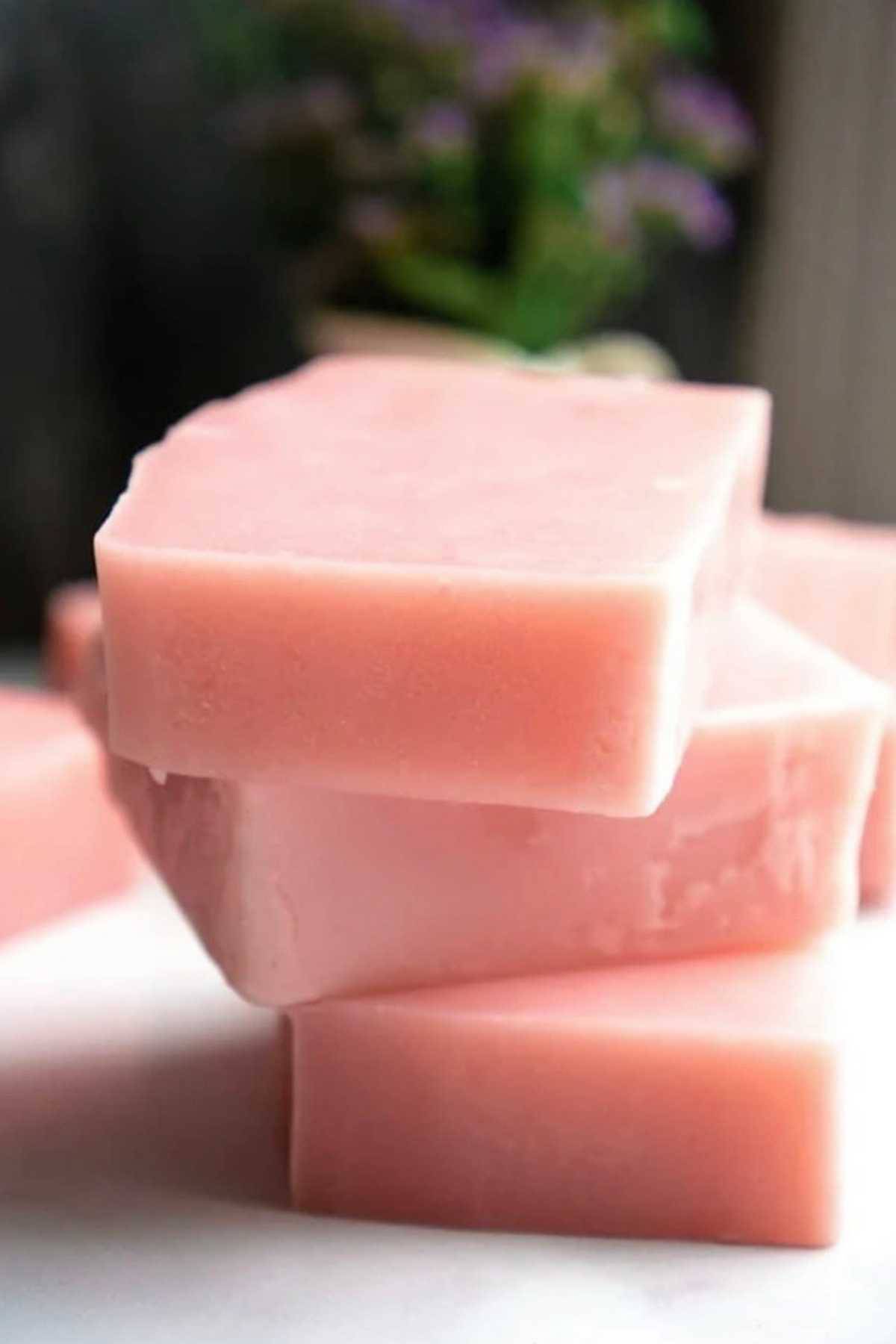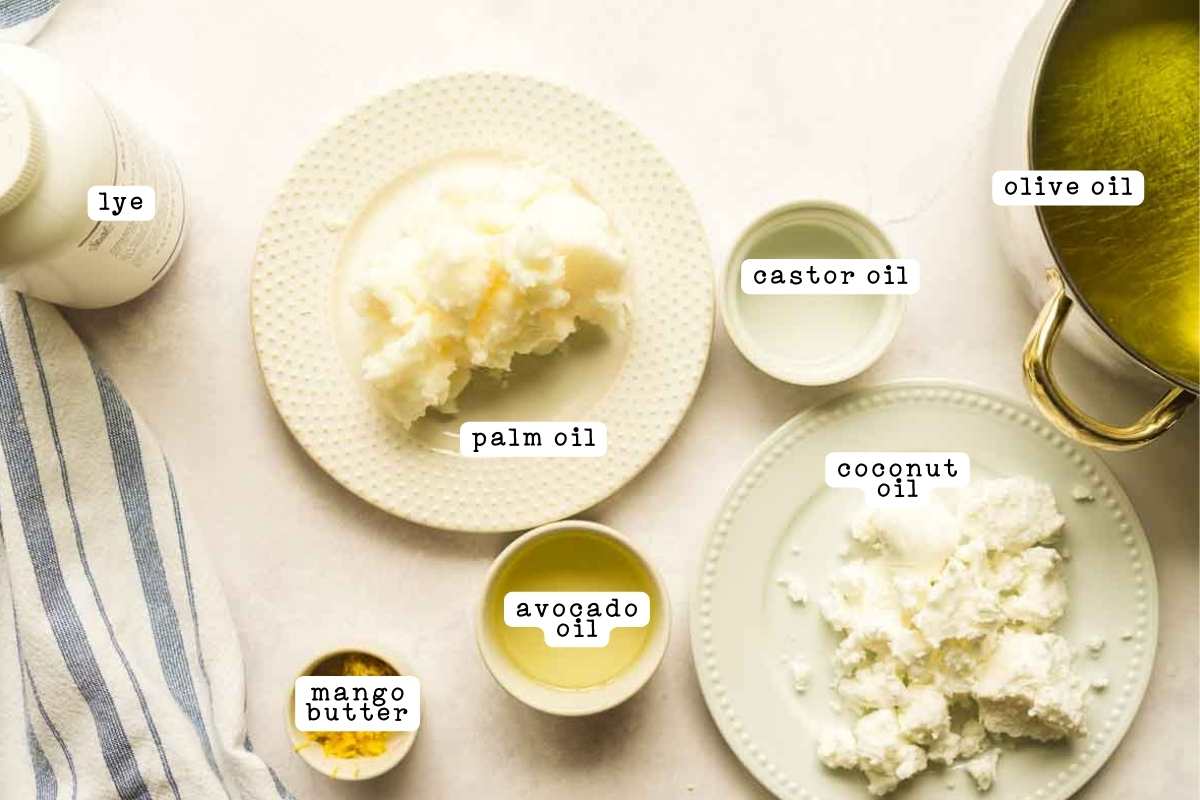How to Make the Best Cold Process Soap: Super Moisturizing and High Lather
This cold-process shower soap recipe is the best ever. It makes a moisturizing yet cleansing bar with tons of lather. Please read below the recipe for tips on substations, safety, and storage, as well as step-by-step photos. If you’re brand new to soapmaking, there’s a lot to learn! You’ll want to watch the video and read the whole post before you start.
The Best Cold Process Soap Recipe

Equipment
- Safety equipment (gloves, goggles, apron)
Ingredients
- 11 ounces coconut oil
- 9 ounces olive oil
- 9 ounces palm oil
- 2 ounces sweet almond oil
- 4 ounces castor oil
- 4 ounces avocado oil
- 2 ounces mango butter
- 5.83 ounces lye
- 10-15 ounces water
- 3 tablespoons fragrance oil for a strong scent, vary this to your preferences
- 2 teaspoons sodium lactate optional, for a harder bar
- colorant or mica optional
Save This Recipe
You'll join my email list which you will love. And if you don't, unsubscribe in one click. ❤️
Instructions
- Make lye water. Using a digital scale, measure out the lye and water in separate glass containers. Combine them by adding the lye to the water. (Remember: snow floats on the lake.). Stir until the lye dissolves. The temperature will shoot up. Place this in a safe place to cool.

- Melt oils and butters. While the lye solution is cooling, measure out the oils and butters and combine them in a large stainless pot. Melt them over low heat and heat them up to 130-140 degrees. Set them aside to cool.

- Let cool. After 2 hours, check the temperature of both solutions. They should be around 110 degrees. (A range of 100-120 is fine.). If not, allow them to cool longer.
- Prep for mixing. Prepare your mold and measure out any fragrance or color you will be adding. (For best blending of colors, mix some color into a few drops of melted oils.). If using sodium lactate, add it to the lye water at this time.
- Blend to trace. Pour the water and lye solution into the pot with the melted oils. Blend with a stick blender until thin trace is reached. The soap batter will noticeable thicken and a trail of soap will sit on top of the liquid rather than immediately sinking in. (This will take about 1 minute.). Add the color and fragrance and stir by hand.

- Pour in mold. Immediately pour the soap batter into the mold. Place in a turned-off oven or wrap with blankets to insulate the soap.

- Cut bars and let cure. After 24 hours of curing, unmold and cut into bars. The bars may seem slightly soft but will harden considerably during the curing process. Allow to cure at least 3 weeks in a well-ventilated place.

Video
Notes
Did You Make This?
I would love it if you would leave a review!
Ingredient Substitutions and Notes

- Coconut Oil: A staple in soap making, coconut oil provides a rich lather and hardness to the soap. It is highly cleansing and can strip away excess oil, making it ideal for oily skin types.
- Olive Oil: Known for its moisturizing properties, olive oil makes the soap smoother and less drying. It’s great for sensitive skin and contributes to the soap’s gentle cleansing ability.
- Palm Oil: Adds hardness to your soap bars, helping them maintain shape and last longer. It also contributes to lather quality, though it’s important to source sustainably due to environmental concerns.
- Sweet Almond Oil: This oil is excellent for its conditioning properties, adding softness and an elegant feel to the soap. It’s suitable for all skin types, especially dry skin.
- Castor Oil: A unique ingredient that boosts lather, making your soap rich and creamy. It’s also hydrating and helps draw moisture to the skin.
- Avocado Oil: Loaded with vitamins and minerals, avocado oil enhances the moisturizing power of your soap. It’s particularly good for dry and sensitive skin.
- Mango Butter: Provides a conditioning and moisturizing effect, making the soap more luxurious. Mango butter is rich in antioxidants and can help to soothe and soften the skin.
- Lye (Sodium Hydroxide): Essential for saponification, the chemical reaction that creates soap. Lye must be handled with care, but it is completely safe once the soap has cured.
- Water: Acts as a solvent for the lye and helps to control the saponification process. Distilled water is best to prevent any impurities from affecting the soap.
- Fragrance Oil: Adds a personal touch to your soap with your favorite scents. Quality fragrance oils are designed to be skin-safe and can significantly influence the sensory experience of using your soap.
- Sodium Lactate (optional): A salt solution that makes the soap bar harder and easier to unmold. While optional, it’s beneficial for achieving a smoother finish.
- Colorant or Mica (optional): These additives bring vibrant colors to your soap, enhancing its visual appeal. They can be used to achieve a wide range of artistic effects, like swirls or layers.
Storage Instructions
Once fully cured, homemade soap should be stored in a dry, well-ventilated spot. I like to put it in shoe boxes in the closet with layers of newspaper in between the bars.
While it is in use, use a soap saver to keep your bar dry. It will last much longer.
Common Issues and Fixes
A 10-inch silicone mold. It’s my favorite for most soaps.
If your soap is too soft, it might need more time to cure. Adding sodium lactate or using oils with higher stearic acid content can also help create a harder bar.
It is a pink mica from Nurture Soap. You can find it here.
Yes, absolutely. I’d recommend using sodium lactate since it can be a bit soft when unmolding it.
This is a 100% personal preference (except for the fact that florals are more difficult to work with). My personal favorites are Comfort and Joy from Nurture Soap and Mango Mango from Brambleberry.
Yes! I used to swirl it all the time before I got too lazy.
You sure can. You’ll need the following percentages:
Coconut Oil: 26.83%
Mango Butter: 4.88%
Olive Oil: 21.95%
Palm Oil: 21.95%
Sweet Almond Oil: 4.88%
Enter them into a soap calculator with the desired size of your batch and it will give you the correct amounts.
The gel phase is a part of the saponification process where the soap heats up and becomes translucent. This can help create a smoother, more uniform bar.
Yes, essential oils can be used as a natural alternative to fragrance oils. Just be sure to use skin-safe essential oils and follow recommended usage rates.
This recipe is a great way to start, but if it’s your first time, you might want to try a more basic recipe with fewer oils. Cold process soapmaking can be complex, so starting simple is a good idea.
Distilled water is free from impurities that can affect the chemical reaction during the saponification process. Using distilled water ensures a more consistent result.
More Great Cold Process Soap Recipes:
- Mix-ins are fun! Try this gardener’s soap recipe.
- You can make your own bar dish soap.
- If you’re looking for something palm-free, try my grapefruit soap bar.
As you continue soap-making journey, remember the importance of safety, stay patient and careful, and enjoy of crafting something with your own hands.
Love,















Hey KAtie! this recipe looks really good and i want to get better at soap making.
However I want re scale the ingredients. Can you tell me what’s the superfattening and lye concentration in this recipe?
Thanks a lot!!!!
Hi
I’m wondering if you need to count the colour amount in your calculation or can you just add a colour .
Thank you
I’ve been exploring soap making – research stage – and your videos and posts are incredibly helpful!! Quick question please: After you cut the soap and are waiting the weeks to use it, how best does it need to be stored? Each bar separated and laying flat or can they be stacked? Covered/wrapped or open air?
I am hoping to make it in one location, but will be moving to another for the winter, so want to know if or how I can transport the bars. Thank you!
Hi Lorna! I typically lay them flat for the first few days: on an old tea towel laid on top of a baking sheet so I can move them out of the way if needed. Then I put them in a cardboard box in between layers of newspaper. They need some air.
Hi Kate, can you recommend a good scent for this pretty pink soap? I am new at this and was wondering what you used.
Thank you for sharing, I am so excited to try it.
My favorite fragrance is called Mango Mango from Brambleberry: sweet and fruity. If you like florals, they have a nice lilac, and for fresh scents, a lemony one called energy.
Hi Katie in the recipe it says 3T of fragrance is that Teaspoons? Sorry if this sounds silly I’ve got everything but sweet almond oil to try this recipe thank you😌
tablespoons 🙂 sounds like a lot but it fades as it cures.
Hi Katie,
How much sodium lactate do we use?
Thanks
Karen
HI Katie – I’m excited to try this recipe. Would this work if I used a soap base and not lye directly?
Thanks
hi karen, no this is just for cold process soap. 🙂 you could definitely add the color and your favorite fragrance to a soap base though!
Hi! I as wondering why it says to cure the poured batter in a warm place rather than the freezer? Also, can I substitute the water with goat’s milk?
goats milk is fine: i do a warm place to force gel phase, but this is optional. freezer is fine!
Does it matter what temp the water is before adding the lye?
just not too hot… room temp is good
I want to say thank you for helping us future soap makers. to help us learn how to make soap the Right way! God Bless
Hi Katie, i just want to make sure your superfat for this recipe is 5%
Thanks.
Kani
yes, 5%! 🙂
Hi Katie
Can you tell me what you used to get this beautiful pink color. I make bars that are not swirls of color and this picture is what I would like to achieve. Thanks
Hi Eileen this is hot pink mica from Brambleberry. You don’t need much, it’s very vibrant!
I’m sure you’re soaps are amazing,but I’m not willing to try anyone’s recipe that contains palm oil, with your experience can you recommend something else please. Thanks.
hi diane, try babbasou or a blend of 60% olive and 40% shea to replace the weight of the palm. run it through a lye calculator first 🙂
Hello, thank you very much for this lovely recipe. What is the exact amount of water that we need to put please? I can see in the reicep that it says 10-15 oz water.
I want to do a very small batch because I am so new and I am afraid of messing it up. However when I am resizing on soap calc it is asking for the superfat amount and lye concentration amount. Could you please enlighten me on those. I am too excited to try your recipe.
I had tried another basic recipe from the net and it turned out not too well for me unfortunately.
Where I live I get palm olein oil instead of palm oil. Is it ok to use? Is it almost the same.
Thank you SO much.
Edit: I went to your recommended lye calculator and was able to find the lye amount. But still confused as to how much water exactly I should use if I would like a 5% superfat.
Thank you again
hi sam- the lye amount and oils are what determines the superfat. so it will 5% no matter what amount of water you use. the water will affect how quickly the soap batter comes to trace and how fast it cures. so it’s really personal preference and doesn’t affect the finished bar, just the process. i’ve never used palm olein oil so i’m not sure how it would change the recipe.
HI Katie If I want to make a very large batch of this soap (like 6 or 7 loafs) then any pointers or advice you can give me? and how do I know how much to put when entering info in the lye calculator? and which lye calculator do you recommend>?
hi lisa! my favorite lye calculator is from thee sage: https://www.the-sage.com/lyecalc/. I’ve never made a batch of this beyond doubling it. When I did that, i simply doubled the amounts in the reccipe I iddn’t recalculate anything. wish i could be of more help!
What can I use in place of palm oil?
Can you do multiple colors to do a swirl loaf with this recipe?
yes! i do it all the time.
Please I want to know the quantity of lye & the quantity of oil
hi abisha, the recipe has all of those listed. 🙂
Can I use different types of oils with the same ratios in the recipe? Will it still work?
No, every oil has its own properties and amount of lye that is needed to turn it into soap. At that point you would simply be creating your own recipe that you would run through a lye calculator. if the the calculation work, you will get a bar of soap that will “work” but it will be different than this recipe. there’s nothing wrong with that, of course, it’s just a new creation. 🙂
May I substitute shae butter for the mango?
yes it should be fine! just run through a lye calculator 🙂